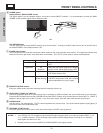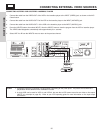
HOW TO SET UP YOUR NEW HITACHI LCD TELEVISION
6
50
50
4" Minimum
4" Minimum
BEST
HORIZONTAL
VIEWING ANGLE
5'
10'
15'
20'
S
S
R
L
VIEWING
The major benefit of the HITACHI LCD Television is its large viewing screen. To see this large
screen at its best, test various locations in the room to find the optimum spot for viewing.
The best picture is seen by sitting directly in front of the TV and about 8 to 18 feet from the
screen.
During daylight hours, reflections from outside light may appear on the screen. If so, drapes
or screens can be used to reduce the reflection or the TV can be located in a different section
of the room.
If the TV’s audio output will be connected to a Hi-Fi system’s external speakers, the best
audio performance will be obtained by placing the speakers equidistant from each side of the
receiver cabinet and as close as possible to the height of the picture screen center. For best
stereo separation, place the external speakers at least four feet from the side of the TV, place
the surround speakers to the side or behind the viewing area. Differences in room sizes and
acoustical environments will require some experimentation with speaker placement for best
performance.
BEST
VERTICAL VIEWING
ANGLE
20
3'
0'
5'
10'
15'
20'
A buzzing sound might be heard when the LCD display monitor is turned on in a very quiet
room. This is due to the LCD panel drive circuit when it is functioning. This arching sound
is normal and it is not a malfunction.
Some infrared rays are emitted from the LCD display monitor’s panel that might affect other
infrared controlling equipment.
When receving still picture signals, (e.g. channel number indication or clock indication) for a
while, you can see image-like when the picture varied. This is not a defect.
The LCD panel is made from glass. Heavy shock on the front panel might damage it.
When the LCD monitor is transported horizontally, the glass panel has the possibility of being
broken or increasing the picture defects. At the time of transportation, horizontal style is
prohibited. More-over, please treat the LCD panel with great care because of a precision
apparatus. Please instruct transporters so that it should be put into the packing box at the time
of shipment.(There is a possibility that breakage of the panel or defects will increase.)
Rough transportation might cause damage to the panel and pixel failure.
When a screen is seen at point-blank range, a random fine grain may be visible to a dark part.
If an apparatus (VCR, etc.) antenna line is arranged near the monitor, the image may shake,
or disturbance may be received.
There is some time lag betweeen the picture and the sound. You can see lip motion that is
delayed compared to the sound.
Storing the LCD television for a period of more than 2 to 3 months without use might cause
an unstable picture when the set is turned on.
Operating altitude: 800 to 1,114hPa (6,194ft to -2,484ft). Operating temperature: 41˚F to 95˚F.
Avoid operating the LCD TV below 41˚F LCD response speed may slow down when operating
at these temperatures. This is a normal operating characteristic of the LCD monitor.
Storage Altitude: 300 to 1,114hPa (31,912ft to -2,484ft). Storage temperature: 5˚F to 140˚F.
Frequent use of the Power ON or OFF might trigger the power protection circuit. If the TV
does not turn ON, please wait a little before turning ON again.
1Arching sound from
LCD display monitor’s
panel.
2Interference for infrared
equipment.
3
Picture Image (Spectrum)
4LCD Surface
5Transportation
6 Granular spot
Black dots and Bright points may appear on the LCD screen. This is a structural property of
the LCD panel and is not a defect.
Black dots and
Bright Points
s
8
7
Disturbance to video
apparatus
9 Lip Sync
10 Caution on prolonged
storage
11 Operating
12 Storage
13 Power ON or OFF
No. Items Notes
IMPORTANT NOTES
FIRST TIME USE


















